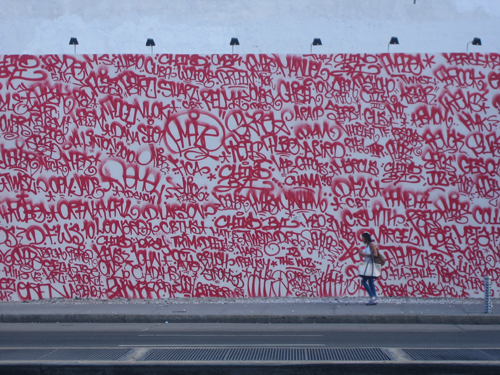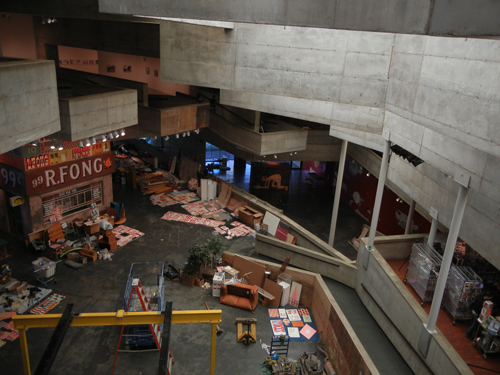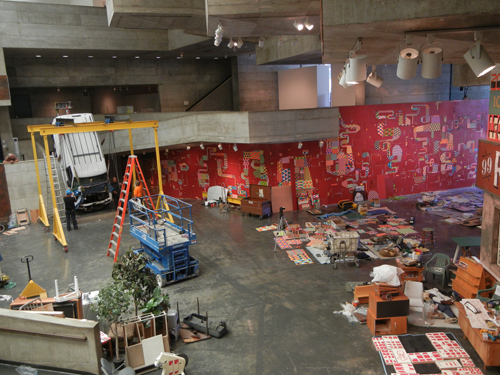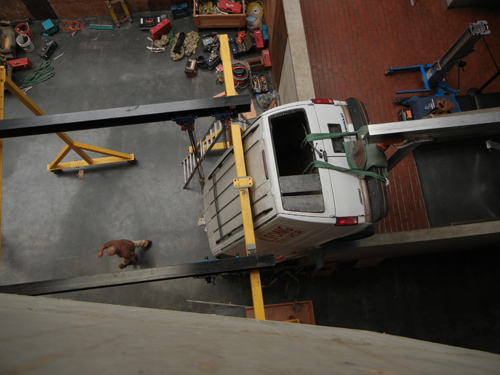McGee, who trained professionally in painting and printmaking at the San Francisco Art Institute, began sharing his work in the 1980s, not in a museum or gallery setting but on the streets of San Francisco, where he developed his skills as a graffiti artist, often using the tag name “Twist.” [...] Using a visual vocabulary drawn from graffiti, comics, hobo art, and sign painting, McGee celebrates his Mission District neighborhood while at the same time calling attention to the harmful effects of capitalism, gentrification, and corporate control of public space. His often-humorous paintings, drawings, and prints -- all wrought with extraordinary skill -- push the boundaries of art: his work can seem refreshingly informal in the gallery but surprisingly elegant on the street.
McGee has long viewed the city itself as a living space for art and activism, but his more recent work has brought the urban condition into the space of the gallery. Increasingly, his installation environments express the anarchic vitality of the inner-city street, incorporating overturned cars and trucks, and often spill beyond the frame of the gallery or museum.
Like (and, in fact, alongside) Matthew Felix Sun, McGee's work came prominently onto my radar a couple of years ago in New York City, where we stayed for a week a few blocks from a large and vigorously beautiful wall at Bowery and Houston that was covered in the artist's graffiti (image at right).
Excitement about the UAM show was palpable as McGee and his assistants took over multiple floors of the museum this summer. Borrowing from Matthew's post of 23 August, Getting Ready for Barry McGee at Berkeley Art Museum, you can see in the photos below how the museum's open spaces were transformed into a muscular, dynamic artist's workshop from which anything might emerge. While under construction, it looked as though whatever the show turned out to be stood a pretty good chance of being straight-up fascinating.
The show opened on 24 August, and Matthew and I stopped by the UAM this past weekend. I wish I could say I enjoyed McGee's work more than I did ... but here's the thing: the vitality of the show's construction had been flattened by the time the galleries were opened to visitors. The museum blurb quoted above claims that McGee's "installation environments express the anarchic vitality of the inner-city street"; I wasn't convinced.
The four-man tagging team teetering on one another's shoulders atop the on-its-nose van on the museum's ground floor was good for a brief chuckle. But after I watched for a few seconds the joke was over. The spectacle didn't stand up to scrutiny. Yet the topmost dummy's electric-motor-driven arm pretended to spray a gray concrete overlook interminably, in the same repeating arc, and after another minute or two the piece (not to mention the drone of McGee's motor mechanisms echoing off the building's hard walls) had become ... well ... annoying.
Even a change of angle didn't extend my interest.
Overall, my takeaway was that graffiti art belongs on the streets, not confined inside museum walls. What's more, I don't believe McGee thinks differently. I think he knows that graffiti in galleries is, to put it plainly, masturbatory.
The evidence that this is McGee's perspective, and not only mine? Check out R. Fong's bodega, a featured element of the UAM installation, visible in first photo beneath the New York graffiti wall, above. Now take an 8-second look at the view through the window behind the bodega:
McGee's work will be on exhibit at the University Art Museum through December 9, 2012.
Related posts on One Finger Typing:
Jim Campbell's "Exploded Views" at SFMOMA
Richard Serra's "Sequence" at the Stanford Art Museum
Shape, stone, seeing: Andy Goldsworthy, Richard Long, Michael Ondaatje









This is a very interesting review - I do agree with your assessment. I am no fan of graffiti but I enjoyed seeing his work in New York greatly. I enjoyed the chaotic scene of the installation process for this show very much too. But the final product, was a sanitized shadow of the real thing. Harmless, and bloodless. Wie Schade.
ReplyDeleteMatthew Felix